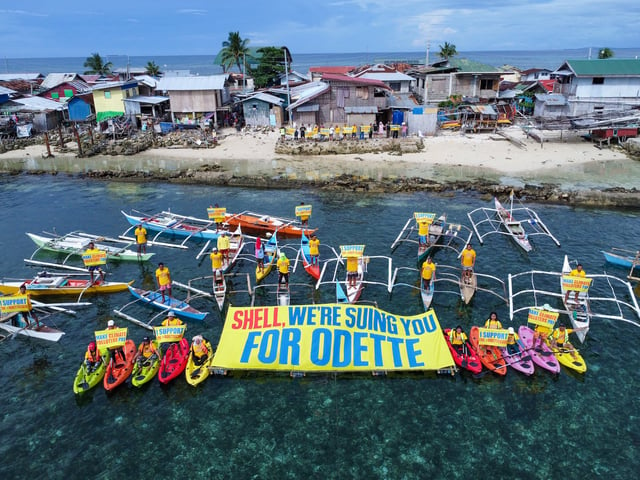
Photo: Parque Nacional Huascaran in Huaraz, Peru, by Lilian Viana, CC BY-SA 4.0, via Wikimedia Commons
Shots fired—that is how observers described the landmark legal decision in late May in a case brought by a Peruvian farmer against a German coal giant, that ruled fossil fuel producers could be held accountable under German law for the climate harms they have caused around the world. It was a groundbreaking moment, a decade in the making, that began in 2015 when Saul Lucian Lliuya realized he had a problem: the constant threat of catastrophic flooding he and the other 120,000 residents of his hometown, Huaraz, faced. Above Huaraz sits Lake Palcacocha, one of several glacier lakes that supplies the city’s drinking water. Over decades, water levels have occasionally risen, but as global average temperatures have increased, the surrounding glaciers have shrunk, pushing the lake to capacity and the point where a catastrophic flood is now inevitable.
None of this happened by chance. Pointing to the science that climate change was being driven by fossil fuel production, the Peruvian farmer from a city in the foothills of the Andes set out to do something ambitious: sue German coal-fired power producer RWE for its part in helping to drive catastrophic climate change. Few thought the case would last as long as it did, and when the court issued its historic ruling in May, headlines in major international papers reported it as a loss. What they missed is that Lliuya had succeeded in laying a blueprint for others looking to take fossil fuel companies to court.
The story of Huaraz is a familiar one to many communities in the Global South. A lack of action by governments and international institutions has meant there are precious few avenues available to find the money and resources needed for adaptation and mitigation. Some estimates put the level of compensation owed by developed economies to Global South countries for their role in driving catastrophic climate change at US$192 trillion. At the COP in Baku, Azerbaijan last year, the annual UN climate summit, governments pledged $300bn, a fraction of what is needed, and the latest in a string of pledges that have remained unfulfilled.
Suing those directly responsible offers a way to both hold companies to account and to secure the resources needed to mitigate emissions, and adapt to climate harms as they develop. These legal efforts have been aided by the development of rapid and more advanced attribution science that makes it possible to link individual fossil fuel producers to specific climate harms.
But then, Lliuya’s claim was never really about the money. At heart was a demand RWE pay 0.47% of the cost of a new dam for his city, a figure estimated at USD$4m and a sum that came to roughly USD$20,000 for RWE’s contribution – a rounding error on the company’s balance sheet.
Both Lliuya and RWE’s lawyers, however, understood there was something bigger at stake. When asked by the court if RWE would be willing to settle, the company’s lawyers refused.
“This is a matter of precedent,” they said.
Unlike earlier tobacco and asbestos lawsuits, establishing liability for an individual company’s role in causing climate change is scientifically possible but legally vastly more complex. When Lliuya’s legal team filed the papers to begin proceedings it was not clear if such a challenge was even possible, let alone how it may be carried out. For both those looking to hold fossil fuel companies to account, and the industry itself, everything was at stake.
A failure by Lliuya might have choked off an avenue for legal accountability; a failure by RWE might have cost billions, if not trillions in the long-run. Founded in 1890, the company had been responsible for over a century of planet-heating greenhouse gas emissions and it belonged to an industrial group that once bragged about the glacier melting power of burning oil, gas and coal. Companies such as Humble Energy, a precursor to ExxonMobil, even used this fact in their early advertising.

In 2017, the situation looked good for RWE when the District Court of Essen dismissed the case, saying parliament and politics were best positioned to address questions about how to deal with climate change. As Lliuya and his legal team appealed, RWE objected. Among the bigger questions: Did the court even have authority to hear the case? With companies headquartered in one country, potentially operating in a second and harms arising in a third, shouldn’t a Peruvian farmer sue in a Peruvian court? Other questions included how the court would engage with the scientific evidence showing that an individual company caused a particular harm, given the complexity of climatic systems. Even if they could, RWE suggested, they were only a minor contributor to a vast, global problem. Then there were specific legal questions: What evidentiary and legal thresholds had to be met? If Lliuya and his legal team were successful, RWE suggested at one point, wouldn’t that open up a broad-ranging legal liability that anyone, anywhere could exploit? Wouldn’t a win by Lliuya mean the average German motorist might be at risk of a lawsuit because the car they drove to work every day relied on burning fossil fuels?
When the court’s decision was handed down on 28 May 2025, while the judges didn’t require RWE to pay up for the dam, they did side with Lliuya on all the key questions of law. The ruling held that German courts do have authority to hear civil claims for climate harms arising from impacts from climate change. A Peruvian could, in fact, sue in German courts under the law of nuisance if it could be shown a German had caused harm to his property – even if said property was on the other side of the world. This was partly due to provisions within German law that require neighbors to consider how their actions affect each other, ruling “the plaintiff is not obliged to tolerate” a disturbance to his property. It also rejected any suggestion Lliuya was “co-responsible” for potential harm simply by living in an at-risk area.
In other words, says Petra Minnerop, a professor of international law at Durham university, the decision means that someone in Tuvalu whose home is affected by sea level rise, or a person in Pakistan whose home is destroyed in a catastrophic flood could potentially sue for climate harms – within certain limits.
“It would still be wrong to say everyone in Switzerland can now sue RWE,” Minerop says. “Even if you have a concrete event, you would need to demonstrate that there is attribution between this event and the harm, so you would need to have a study that exactly demonstrates that.”
Over the course of the judgment the court went further still. A reasonable person, it found, would have foreseen from at least 1958, thanks to the work of Charles Keeling, whose lab was funded by fossil fuel and automotive companies, that burning oil, gas and coal had the potential to cause long-term harm.
“Based on generally known facts, the Senate is convinced that it was already foreseeable in the mid-1960s for an optimal observer in the role of an energy producer that anthropogenic greenhouse gas emissions would lead to global warming and the associated consequences,” the court held.
With this statement the court offered a direct rebuke to decades of deception about the science of climate change. Its additional findings on causation—that a specific company could be held responsible for specific climate harms—made for a “historic” decision that Sebastien Duyck, a senior attorney with the Centre for International Environmental Law says marked the end of “impunity” for fossil fuel producers.
“The judge was very clear in his reading of the case that, at the end of the day, if there is evidence that demonstrates a company is responsible for a fraction of historical global emissions, because every fraction of warming matters, this company could be held accountable for the harm that is proportional to climate chaos, to the climate crisis,” Duyck says. “The decision very clearly dismissed the argument that RWE was just a minor contributor.”
In a statement issued after the landmark judgment, Saul Luciano Lliuya expressed disappointment the court did not grant his claim for compensation, but celebrated the new ground broken in the legal fight for “all the people who, like us in Huaraz, are already living with the consequences of a crisis we did not create.”
“Today the mountains have won,” Lliuya said.
RWE, however, similarly claimed victory and early reporting of the decision framed the result in terms that were favorable to the company, thanks in part to its spin. In its own statement, RWE claimed Lliuya’s attempt to establish a precedent had “failed” on the basis that it wasn’t forced to pay compensation and that the court had found “no imminent danger for the plaintiff’s property”.
Friederike Otto, a climate scientist and senior lecturer at the Grantham Institution for Climate Change and the Environment at Imperial College London, says this is not accurate as the court clearly recognized the validity of scientific work linking individual producers to specific harms.
“What the court did here is to say, very clearly, that a fossil fuel company like RWE can be held liable for damages they cause across the world by just going about their business,” Otto says. “[The court] very, very clearly lays out this causal chain by saying that the oil that you dig up counts, that the only thing that you can do with that is burn it, that will cause emissions, and those emissions will cause damage across the world.”
There are already hopes the decision may provide guidance for courts in countries such as Switzerland and Belgium, and that it might inform decisions in related jurisdictions such as the UK, the Netherlands, Canada, the US, Japan and Australia. Isabelle Reinecke, an Australian lawyer and executive director of the not for profit legal fund Grata Fund, says the German decision is “a really exciting development and one that should be paid attention to” in other jurisdictions.
“The way that law works in emerging areas where there’s new facts is that it’s a wall that gets built brick by brick, and this is a significant new brick,” Reinecke says. “This is an area of law, particularly around causation, that is already being grappled with by courts around the world, and we know that courts share information about how they deal with issues.”
“Traditionally, in Australia, you have needed a much higher rate of contribution to be accountable,” she adds. “But what the court [in Germany] is here saying is that even a relatively small piece of the pie, at 0.47% percent of the global pie, that is enough to establish a causal link. Because every tonne emitted has a linear increase relationship with temperatures, it doesn’t matter how small the contributions.”
The consequences, however, may extend well beyond the courtroom. With individual companies now open to liability for the harms caused by their emissions under German law, other jurisdictions are likely to follow. This decision and others in the future will inevitably be factored into the financial calculations of those helping to enable fossil fuel extraction such as insurance companies, banks and transportation firms. More significantly, there is hope that cases like Lliuya’s may help shift the popular narrative among the public and political leaders in the same way that tobacco lawsuits changed the way people once thought about cigarettes.
“People don't really appreciate just how much deception has been going on,” Otto says. “What I see in my daily work all the time is that people do believe us that it's climate change, but they still don't quite understand and continue to believe that these companies are doing something good.”
“I think actually RWE have lost the battle, and now the war can begin.”




